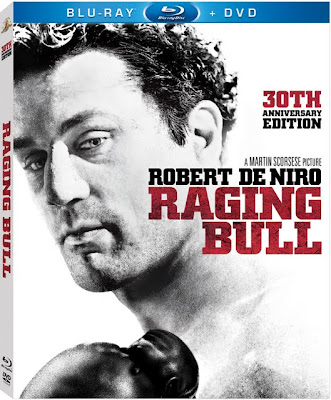Regardless of differences in the medium, message and/or methodology, undoubtedly the ultimate goal of those who “create” – as a career or out of compulsion – is to share their own particular point-of-view with others.
And as seemingly impossible and staggeringly impressive as it is to create even one unparalleled cinematic instant classic, because filmmaker Martin Scorsese's career is essentially overflowing with masterpieces, it's become challenging not only to identify which film we could call his Magnum opus but also just what it is that sets his movies apart from the rest.
On the surface, the films are viscerally potent and -- in the case of Raging Bull
And in doing so with the good fortune of this flawless high definition restoration and Blu-ray print transfer of the Library of Congress dubbed “National Treasure,” you're struck by how intensely personal Scorsese's 1980 epic is to the point wherein it's almost as if instead of only focusing on boxer Jake LaMotta, Scorsese was also sharing with us a portion of himself at the exact same time.
It's a feat that's all the more impressive considering the tremendous amount of work involved in the art of filmmaking. For unlike painters musicians and writers who have the utmost control over the execution of their craft, it takes vast numbers of craftsman, collaborators and (sometimes) corporations to deliver a film from initial concept to final cut.
But rather than embrace the style of semi-autobiographical cathartic filmmaking made popular in the '70s as seen in Bob Fosse's extraordinarily experimental confessional opus All that Jazz
Yet as daring as the concept was, everything comes together in Scorsese's magnificent Raging Bull
The description of Bull as a labor of love is incredibly fitting given the fact that the sheer passion and raw power evident in his towering performance culminated in the Oscar awarded to Robert De Niro, who'd been obsessed with the project for years after reading LaMotta's biography while filming his first Oscar winning performance in The Godfather, Part II
Unfortunately convincing Scorsese to commit was a different story altogether as he was hesitant to tackle a boxing movie, particularly after the phenomenal success of Sylvester Stallone's underdog crowd-pleaser Rocky
Nevertheless, eventually Scorsese wound up changing his mind in a heart-to-heart conversation shared with De Niro after the filmmaker suffered an overdose and begin thinking of Jake La Motta's plight as a fighter in the ring as a metaphor for handling life's right-hooks head-on.
An altogether different take on a boxing film, Scorsese's highly personal handling of the material inspired a cinematic renaissance in not just biopics but the entire –and previously wholly predictable – onscreen depiction of athletics, taking us inside the ring to make viewers feel just as vulnerable, off-balance yet oddly adrenaline fueled as the fighters.
And further linking the idea that when done correctly, fight choreography should be as engrossing, authentic and awe-inspiring as dance sequences in musicals, in addition to having cinematographer Michael Chapman be opposite De Niro to give us the opponent's-eye-view of the fight, Bull employed Arthur Murray dance school techniques to expertly choreograph some of La Motta's most famous matches.
Shot in black and white for a multitude of reasons in keeping it authentic for the time period overall, Bull is as hauntingly gorgeous as it is unflinchingly gritty. And frequently, it repels and seduces us within mere seconds of screen time, moving from a horrific nightclub fight between Jake's loyal yet long-suffering brother Joey (a tremendous Joe Pesci) and a mobster that fades right into an idyllic rainy day establishing shot.
While as in a majority of Scorsese films including subsequent De Niro/Pesci opuses like GoodFellas
Disconcerting in its Kubrickian Lolita
Aesthetically, Scorsese's odyssey is reminiscent of a European-American hybrid of Fellini
In stark contrast to the brutality on display, Bull is both artistically inspiring and endlessly surprising from utilizing a beautiful classical track from Scorsese's own record collection for the main title sequence to incorporating lines from both Richard III
Creatively autobiographical while essentially biographical, Scorsese's “personal” masterpiece is “given a stage where [his] Bull
Martin Scorsese
Text ©2011, Film Intuition, LLC; All Rights Reserved. http://www.filmintuition.com Unauthorized Reproduction or Publication Elsewhere is Strictly Prohibited and in violation of the Digital Millennium Copyright Act.
FTC Disclosure: Per standard professional practice, I received a review copy of this title in order to evaluate it for my readers, which had no impact whatsoever on whether or not it received a favorable or unfavorable critique.













